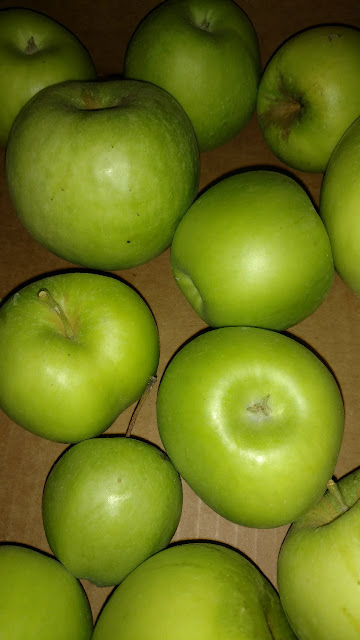
|
|
Granny Smith apples will keep longer off the tree than
early-season varieties. (Photo: Debbie Arrington)
|
Apple time tips: How to pick a perfect Granny Smith and more
It's apple time! October is peak harvest for apples in the greater Sacramento area including nearby Apple Hill near Placerville.
If you have backyard trees or visiting a pick-your-own orchard, how do you tell if an apple is ready?
Apple trees tend to ripen their fruit from the outside in. Apples that developed on the tree's outer edges will be ready before apples that grew closer to the trunk.
Color is a clue, but not a decider. Granny Smiths stay green when ripe. Other varieties such as McIntosh and Braeburn retain some green color as they blush red.
The easiest way to tell if an apple is ripe is taste it. Pick a sample, cut it open and try it. Notice the seeds; that's another clue. Mature apples will have brown seeds.
A ripe apple is easy to pick. With a little upward twist, it separates from the tree without pulling.
When picking, treat apples like eggs. They bruise and nick easily, which hurts their long-term storage.
Late-season apples such as Granny Smith, Rome and Fuji tend to have thicker skins and will keep longer off the tree. Red or Yellow Delicious and Gala varieties, all known for their sweetness, have thinner skins; they'll last weeks instead of months in storage.
Apples will continue to develop off the tree, eventually becoming soft and mushy. According to growers, one bad apple will indeed spoil the bunch. Cull any damaged or bruised apples (they're fine for eating fresh or cooking) before storing.
How to store those apples? Ideally, at 35 degrees F. in the crisper drawer of the refrigerator. Store the apples in a plastic bag with holes punched in it.
If you have a lot of apples, store them in a cool, relatively dark place such as a garage. To keep them fresh for as long as possible, wrap each apple (preferably with stem attached) in newspaper and place in a single layer.
Want to know more about apples or get some of the new harvest? Apple Hill's farms are now open. Details:
www.applehill.com
.
Besides harvesting apples, here are other garden tasks this week:
* Harvest pumpkins and winter squash.
* Divide and replant perennials such as bearded iris, Shasta daisy and asters.
* Plant directly from seed such spring flowers as cornflower, nasturtium, nigella, poppy, portulaca, sweet pea and stock.
* Set out cool-weather bedding plants, including calendula, pansy, snapdragon, primrose and viola.
* Plant seeds for radishes, bok choy, mustard, spinach and peas. Plant garlic and onions.
* Transplant lettuce, cabbage, broccoli, kale and cauliflower.
* Reseed and feed the lawn. Work on bare spots.

